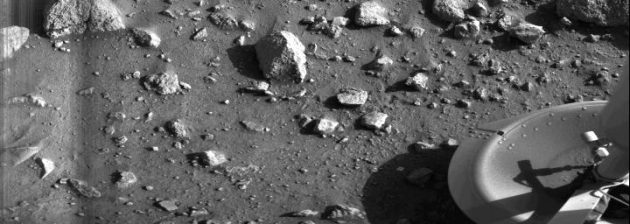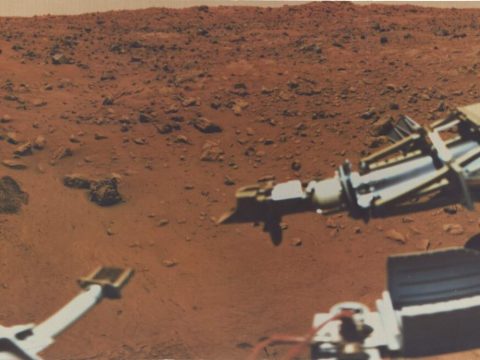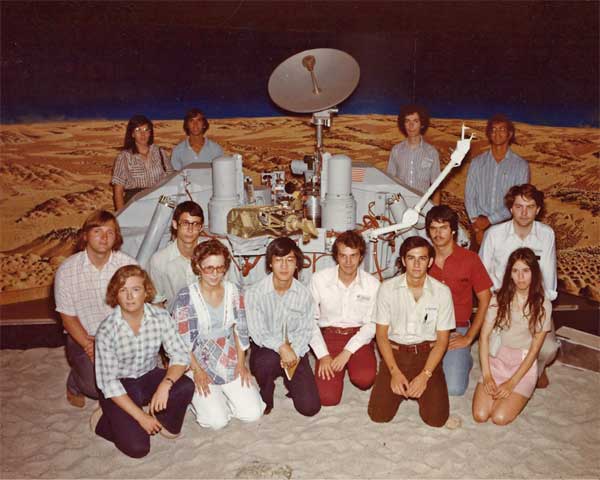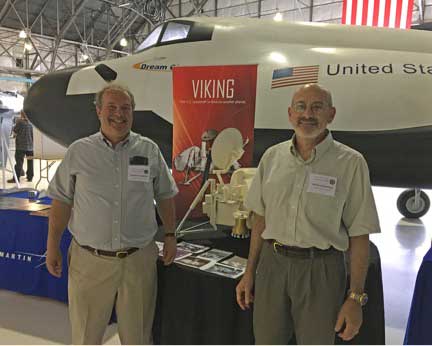July 20. The date is instantly recognizable to space enthusiasts as the anniversary of the Apollo 11 Moon landing in 1969. But another major space-exploration anniversary shares the same date. Can you name which one? Perhaps if you’re a Baby Boomer.
On July 20, 1976, NASA’s Viking 1 lander touched down safely on Mars, becoming the first spacecraft to do so. The milestone was originally scheduled for July 4th, to coincide with the U.S. bicentennial celebration. But images from the Viking 1 orbiter — the lander’s mother ship — revealed the planned landing site to be more boulder-strewn than expected. It took 16 days for mission scientists to find a less hazardous alternative. Two months later, on September 3rd, the twin Viking 2 lander also made a successful touchdown.

NASA / JPL
This past Saturday, July 16th, some 200 of the mission’s surviving scientists and engineers and their families, along with many younger space explorers inspired by the Vikings, gathered at the Wings Over the Rockies Air & Space Museum in Denver, Colorado, to celebrate the 40th anniversary of the Viking 1 landing.
The event was organized by Rachel Tillman, executive director of the Viking Mars Missions Education and Preservation Project. As the daughter of Jim Tillman, a member of Viking’s meteorology team, Rachel literally grew up with the mission and has known most of its team members — if not personally, at least by name — for nearly her entire life.
Why Denver? Because it’s home to aerospace giant Lockheed Martin, which in an earlier incarnation (as Martin Marietta) designed, built, tested, and flew the Viking landers. Mission control and the science operations center were located at the Jet Propulsion Laboratory (JPL) in Pasadena, California, which is where the action was during that historic summer of 1976 — other than on Mars itself, of course!
Celebrating Once and Future Mars Exploration
Throughout the day visitors to the museum browsed special exhibits about Viking and subsequent Mars missions. They also had the opportunity to interact one-on-one with scientists and engineers from across the country. Most of the museum’s younger visitors (and many of their parents) had never heard of Project Viking and were excited to hear stories of what it was like to be part of such an ambitious undertaking.
After the museum closed to the public, Tillman and her crew set up a lavish barbecue buffet dinner and invited several senior Vikings to offer brief reminiscences. Pat DeMartine, who developed software for the spacecrafts’ computers, recalled the team’s collective opinion that there was maybe a 50% chance that one of the two landers would make it to the surface intact. He described the fact that they both did, and then operated on Mars for several years beyond their planned 90-day lifetimes, as “spectacular, unbelievable!”

NASA
Ben Clark, who worked on the landers’ soil-chemistry experiment, talked about the aspect of Viking that attracted the most attention from the news media and public: the search for evidence of past or present life on the Red Planet. Each lander carried three instruments designed to look for different chemical or biological signatures of living (or once-living) organisms. When the landers’ soil scoops delivered samples to the three experiments, both spacecraft produced similar results: one instrument reported a positive detection, another a negative one, and the third an ambiguous one. Clark said this lack of clear evidence for life killed NASA’s appetite for Mars exploration for the next 20 years.
Thanks to a new generation of planetary scientists and NASA leaders, Mars missions resumed in the 1990s. A fleet of increasingly sophisticated orbiters, landers, and rovers — not only from the U.S. but also from Europe, Japan, and India — have built a strong case for a warmer, wetter Mars in the past and possible seasonal flows of water in the present. Since liquid water is considered a fundamental requirement for life, interest in Mars is enjoying a tremendous resurgence, much to the aging Vikings’ delight.
Return of the Viking Interns

NASA / JPL
The youngest representatives from the Viking mission at Saturday’s gala were a dozen 60-somethings who had been among the 58 undergraduate interns chosen from more than 600 applicants to spend a month at JPL during the summer of ’76. The internship program — the first of its type at NASA — was the brainchild of lander-imaging-team leader Tim Mutch of Brown University and his colleague Carl Sagan of Cornell University, who was not yet a household name (his Cosmos TV series was still four years away). Its success prompted future missions to offer similar opportunities to college students.
Many Viking interns went on to have illustrious careers in astrophysics, planetary science, aerospace engineering, and related fields. The names of quite a few of them are likely familiar to readers of Sky & Telescope. Among them:
- Steve Albers, who in July 1991 produced what was, at the time, widely regarded as the best-ever photograph of a total solar eclipse;
- Ken Carpenter, one of NASA’s top scientists on the Hubble Space Telescope project;
- Andy Chaikin, who worked at S&T in the 1980s and wrote the best-selling book A Man on the Moon, which was made into an HBO mini-series;
- Nathan “Chip” Cohen, who studied under Carl Sagan at Cornell University, wrote the acclaimed book Gravity’s Lens, and is now a telecommunications tycoon;
- Paul Spudis, a geologist at the Lunar and Planetary Institute and the world’s leading advocate of developing the Moon’s resources;
- David Thompson, the CEO of Orbital Sciences Corp., whose Cygnus spacecraft are resupplying the International Space Station; and...
- me! I worked at S&T for 22 years beginning in 1986, serving the last 8 as Editor in Chief, and am now the press officer for the American Astronomical Society.

Andy Chaikin / Rick Fienberg
 6
6
Comments
July 18, 2016 at 3:56 pm
I was a teenager back then. I was really getting into astronomy as well, reading your competitor. It thrilled me to death to see the surface of Mars. I've had it in my telescope a lot this summer, even seeing some markings at times. Let's hope we can have a manned expedition land there before too much longer. Clear Skies!
You must be logged in to post a comment.
2ndGenViking
July 18, 2016 at 4:10 pm
It was incredible having everyone come together for this event! We are thrilled to have the "youngns" there to honor the incredible hard work of the engineers and planners that began long before launch even.
You Interns, students from CU Boulder, and 4 students we invited from WI, all together to represent the entire chronology of Mars Exploration past and future.
Having Vikings from every mission phase and diverse roles, to represent the full history of the mission was tremendous, and the visitors and Teachers present were astounded at the complexity and success of the mission, as well as learning about the pre launch history, which is longer even than the mission itself (dating back to COSPAR late 50s and research in the early 60s) for the many systems that became the Orbiters, Landers, and Launch vehicles.
Some of the earliest Archives in our dedicated Viking Library are research papers by engineers, academics from around the world, and NASA innovators from around the world and dating back to the 50s.
It was a tremendous honor to meet all of you in person after months and years of planning this event!
Thank you for participating and sharing this remarkable event.
You must be logged in to post a comment.
paolo-gimigliano
July 19, 2016 at 6:02 am
Sto sfogliando The Martian Landscape, pubblicato dalla NASA nel 1978, big emotion, vecchi ricordi sempre vivi. Poter vedere le prime fotografie di Marte, avere tra le mani una pubblicazione della NASA ...emozioni emozioni emozioni.
You must be logged in to post a comment.
postrevolutionary
July 22, 2016 at 4:32 pm
Grazie, Paolo!!!
You must be logged in to post a comment.
GIULIO-PECORA
July 23, 2016 at 5:26 pm
On that summer of 1976 I was a junior editor with the Italian news agency ANSA. At that time news agencies were the main source of news worldwide. The most urgent and important news were dispatched with what was known as a news flash. No more than a few words on a teletype line that began and ended with bells (which actually rang inside all the newsrooms alerting journalists). As an amateur astronomer I literally dreamed of launching the news flash that I had already written in my head: "There is life on Mars, Viking". Forty yeas later teletypes don't spit out news anymore but that news flash could still become a real item with Mars 2020.
You must be logged in to post a comment.
Sam Storch
July 24, 2016 at 1:42 pm
Back in those glorious days the Midas Muffler company distributed posters showing "their" aptly-named rock sitting on the Martian landscape. At the time, one of my students managed to garner the entire "supply" of those posters from a local shop; we gave away literally hundreds of them to interested planetarium visitors.
The public was quite excited by planetary science back then, and authors of introductory level college astronomy textbooks couldn't write new editions fast enough.
I'm glad to have experienced those times.
You must be logged in to post a comment.
You must be logged in to post a comment.